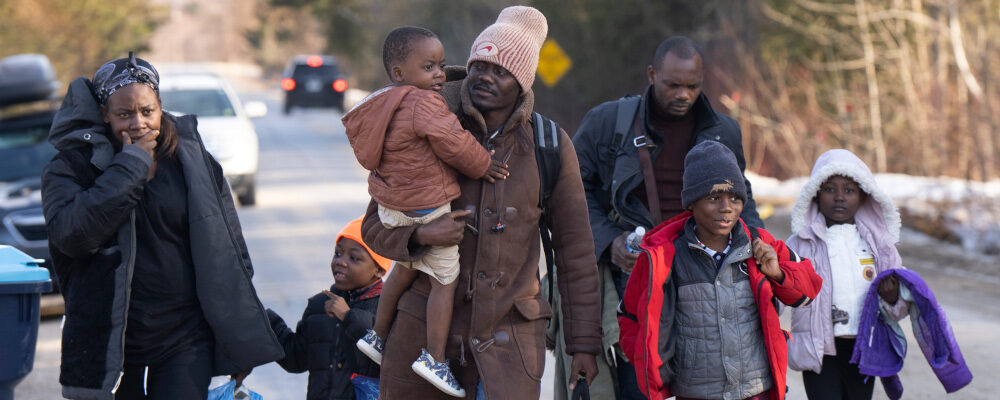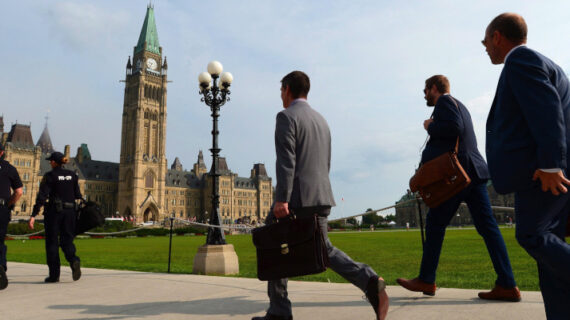It’s always nice when a guest brings a thoughtful gift. Prime Minister Trudeau had reason to be particularly grateful for visiting U.S. President Joe Biden’s agreement to expand the Safe Third Country Agreement (STCA) to cover illegal migration at Roxham Road and all other points along our shared border. It’s something Canadian governments have been asking for for more than a decade, and something Trudeau needed to mollify a Quebec government whose patience at federal inaction had, quite understandably, run out. From Trudeau’s perspective, it was the perfect gift.
From my perspective, it is a good start. But there are still too many loopholes and the revised STCA will require determined enforcement if it is going to be the deterrent that both countries hope it will be. To explain why, it is important to understand what the STCA already was, and wasn’t, and what the new protocol means it could be.
Under the STCA that Jean Chrétien and George W Bush signed in 2002, and which came into effect in 2004, Canada and the United States agreed that if someone from a third country attempted to enter Canada from the United States or vice versa to claim asylum, they would be sent back to make their asylum claim in the country they entered first. This reflected a principle of the 1951 Refugee Convention that persons are expected to end their onward journey from persecution in the first safe country they reach. There is no right to forum shop for asylum.
There were exceptions to the STCA from the beginning. Most notably, it only applied to would-be asylum claimants who presented themselves at an official border crossing. If they arrived at an inland port of entry by train or airplane, it did not apply. And it didn’t apply if you simply walked across the border. Naturally, this is what many migrants started to do, and Roxham Road, with its proximity to transportation by bus and taxi, became the most popular and most notorious illegal crossing point. In 2022, the RCMP intercepted 39,540 migrants along the 5,524 miles of the Canada-U.S. border. Of those, 39,171, or 99 percent, crossed the border into Quebec, and almost all of them at Roxham Road.
There are other loopholes in the STCA, including one for persons who have a relative in the country they would otherwise not be eligible to enter. The definition of “relative” is much broader than that used in most Canadian immigration laws and includes adult siblings, aunts, uncles, nieces, and nephews. This exception is further loosened in practice by the fact that Canada doesn’t typically require persons to prove the relationship. When I worked at the Department of Immigration, I heard of CBSA agents accepting phone calls and hard-to-verify or easily-forged unofficial documents as sufficient evidence. This exception remains, but it could be tightened if Canada insisted on proof by the official government or a DNA test to access it.
The newly-announced protocol to the STCA will close the major loophole. It will allow Canada to send migrants back to the United States to claim asylum there if they are apprehended within 14 days of crossing the border, subject to a few exceptions. It is a significant and welcome improvement to an agreement that had become as porous as our border. Quebec Premier Legault hailed it as a “great victory,” which will no doubt come as a great relief to the prime minister.
The usual critics, of course, issued the usual hysterical denunciations, predicting misery and chaos. They should be ignored. During the COVID pandemic, Canada and the U.S. trialled a form of the current protocol and the number of border-crossings almost completely dried up. That situation can’t be compared directly to today, as travel from the migrants’ countries of origin was also impeded by global travel restrictions, and the Biden administration’s lax approach to the southern U.S. border has seen a marked increase in illegal migration there, which may have a knock-on effect at the northern border. But it shows that cooperation and enforcement can make a difference.
Contrary to what critics say, the new protocol brings Canada and the United States more in line with the letter and spirit of the 1951 Refugee Convention. The convention is anachronistic in many ways, as you would expect of a 72-year-old agreement, but Article 31, which reflects the principle that asylum shopping should not be tolerated, remains relevant.
I have written elsewhere about the negotiation of Article 31, but the short story is that the French delegation sought assurances that the large number of refugees from central and eastern Europe who were in safe third countries bordering France would not be able to continue on into France to make asylum claims. As the French spokesman said, “[t]o admit that a refugee who had settled temporarily in a reception country was free to enter another, would be to grant him a right of immigration which might be exercised for reasons of mere personal convenience.”
The British delegate argued that the language of the initial draft of Article 31, which required a person crossing a border illegally to “show good cause” for his illegal entry into another country, satisfied the French concern. The French disagreed and, in the end, the French concerns prevailed. The final version of Article 31 clearly limits its application to persons “coming directly from a territory where their life or freedom [is] threatened in the sense of Article 1.” That is the principle behind the original STCA, and the new protocol reinforces it.

If the new protocol is a welcome improvement, why do I say that it is only a good first step? There are two main reasons: one that relates to the terms of the protocol itself and one that concerns its enforcement. First, the new protocol contains an exception for undocumented minors, which is a category we have seen exploited at the southern U.S. border with disastrous humanitarian consequences. There is no reason why unaccompanied minors cannot be dealt with in whichever country they entered first, just like any other migrant.
Nothing is gained by creating an exception for them, and much could be lost. Specifically, it will create a dangerous incentive for unscrupulous human smugglers to send underage children on ahead, alone, so that their families can then avail themselves of the exception for relatives once the child is established in Canada. This was a reckless oversight and the exception, not the new general rule, will endanger vulnerable children. And that is assuming we can tell whether a person without papers is a child in the first place—a dodge that central American gangs have exploited for years in the United States.
On the enforcement front, the two-week window to return illegal border-crossers sets up a race against the clock for law enforcement. If we can show quickly that we can catch and return the large majority of migrants, then the deterrent effect of the new protocol will kick in as there will be less incentive for people to try their luck in the first place. Over time, this is the best hope to interrupt established migration patterns and reduce illegal border crossings. But if would-be migrants see that we are not able or interested in enforcing the agreement, or if the refugee lobby is able to use lawfare to convince activist judges to frustrate the agreement, then this week’s agreement will have been in vain.
To ensure the protocol succeeds, Canada should significantly increase its enforcement at all likely crossing points. Contrary to what you often hear from critics of the STCA, there aren’t that many convenient places for migrants to cross the border, especially during the winter. Physical deterrence at these places should be complemented by a major increase in technology—cameras, drones, and invisible fences—to better monitor the border. This all should have been done years ago, but it makes particular sense now.
The government should also ask for U.S. cooperation in setting up joint RCMP-U.S. Border Patrol patrols that would operate on both sides of the border to intercept illegal migrants. These units could be modelled on the existing Shiprider program, which was set up in 2012 to allow the RCMP and the U.S. Coast Guard to conduct joint patrols of the Great Lakes to intercept smuggling.
In addition to these operational challenges, the government should be prepared for a wild card. In 2020, a Federal Court judge ruled that the STCA violated the Charter rights of certain migrants. Sanity prevailed at the Federal Court of Appeal, which overturned the Federal Court decision. Last October, the Supreme Court of Canada—a place where sanity is far from guaranteed—heard the appeal of the case, and the justices’ ruling could come anytime between now and the summer. If the Court is reckless enough to invalidate the STCA, which has been in place for almost two decades, the government should be prepared to step in and use its political powers to save it, and to preserve the gift that Biden just handed them.




